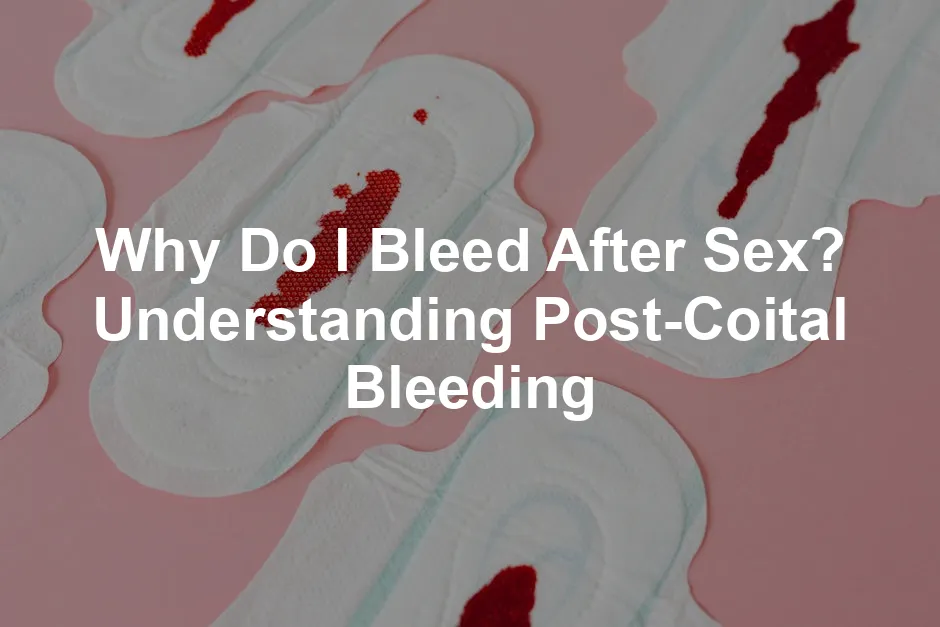
Why Do I Bleed After Sex? Understanding Post-Coital Bleeding
Introduction
Have you ever experienced bleeding after sex? You’re not alone. Many people encounter this situation. It can be concerning, but understanding the causes is crucial. Knowing when to seek medical advice can ease your worries. Let’s break this down together.
Summary and Overview
Post-coital bleeding refers to vaginal bleeding that occurs after sexual intercourse. It affects approximately 6-9% of menstruating individuals. While this bleeding is often harmless, it can sometimes signal serious conditions. Causes can range from minor issues to more significant health concerns. This article will cover definitions, possible causes, emotional implications, and when to seek help.
Common Causes of Bleeding After Sex
Experiencing bleeding after sex can be alarming. It’s essential to understand that various factors can contribute to this issue. Some causes are benign, while others may require medical attention. Let’s explore some common reasons for post-coital bleeding.

Vaginal Dryness and Lack of Lubrication
Vaginal dryness is a frequent cause of bleeding after sex. When there isn’t enough lubrication, friction can occur during intercourse. This friction may irritate sensitive vaginal tissues, leading to bleeding. Hormonal changes often cause dryness, particularly during menopause. Medications, such as antidepressants or antihistamines, may also contribute to this problem. If you experience dryness, consider using water-based personal lubricants to enhance comfort during sex.
Infections
Infections can also lead to post-coital bleeding. Sexually transmitted infections (STIs) like chlamydia and gonorrhea are common culprits. These infections can cause inflammation of the cervix, leading to bleeding during or after sex. Other vaginal infections, such as yeast infections, can also create irritation. Signs of infection may include unusual discharge, itching, or a burning sensation. If you notice these symptoms, consulting a healthcare provider is essential.
Cervical Conditions
Cervical conditions can cause post-coital bleeding as well. Cervical ectropion occurs when the glandular cells of the cervix grow outside their normal area. This condition is often harmless but can lead to bleeding during intercourse. Cervical polyps are another possibility. These are small, benign growths on the cervix that can bleed if irritated. Regular gynecological exams are crucial for identifying these conditions early, ensuring prompt treatment if necessary.
Menstruation and Hormonal Changes
Timing can play a significant role in post-coital bleeding. For many, sexual activity near the start or end of their menstrual cycle can result in bleeding. Hormonal contraceptives may also cause breakthrough bleeding, particularly during the adjustment period. Understanding your menstrual cycle can help clarify when bleeding may occur after sex.
Rare but Serious Conditions
While most causes of post-coital bleeding are benign, some serious conditions warrant attention. Cervical or uterine cancers can cause bleeding during intercourse. Although these cases are rare, being aware of the signs is essential. Symptoms may include persistent bleeding, unusual discharge, or pelvic pain. If you experience these signs, seek medical evaluation promptly.
Understanding the potential causes of bleeding after sex is essential for your health. If you experience this issue frequently, consult a healthcare provider for a thorough evaluation. By staying informed, you can take proactive steps toward maintaining your well-being.

Risk Factors for Post-Coital Bleeding
Several factors can increase the likelihood of bleeding after sex. Understanding these risk factors can help you identify potential concerns.
Age and hormonal changes play a significant role. As women approach menopause, hormone levels fluctuate. This can lead to vaginal dryness, making the tissues more susceptible to tearing during intercourse. Postmenopausal women should be particularly aware of this.
A history of sexually transmitted infections (STIs) is another risk factor. Infections such as chlamydia or gonorrhea can cause inflammation and irritation of the cervix. This inflammation may result in bleeding during or after sex. Regular screenings and safe practices can help mitigate this risk.
Certain contraceptives can also contribute to post-coital bleeding. Hormonal contraceptives, especially during the initial adjustment period, can cause breakthrough bleeding. This is typically not a cause for alarm, but consistent bleeding may warrant a discussion with your healthcare provider.
Recent childbirth or menopause can lead to changes in vaginal health. After childbirth, the body undergoes numerous adjustments, which can include temporary bleeding or spotting. Menopause also brings about significant hormonal changes that may lead to dryness and increased fragility of vaginal tissues.
Awareness of these risk factors can empower you to seek medical advice when needed. Regular check-ups and open discussions with your healthcare provider are essential for maintaining your reproductive health.

When to Seek Medical Attention
Knowing when to seek medical attention for post-coital bleeding is vital. While occasional light bleeding may not be concerning, certain scenarios require prompt evaluation.
If you experience heavy or persistent bleeding after sex, it’s crucial to consult a healthcare provider. This is especially important if the bleeding lasts longer than a few days or becomes heavier than your typical menstrual flow. Heavy bleeding can indicate underlying health issues that need addressing.
Accompanying symptoms like pain or fever should also prompt a visit to your doctor. Pain during or after intercourse, along with fever, could signal infections or other serious conditions. Pay attention to any unusual discharge, odor, or changes in your menstrual cycle.
Post-menopausal individuals should be particularly cautious. Any vaginal bleeding after menopause is not normal and should always be evaluated by a healthcare professional. It could be a sign of a more serious condition, including potential cancers.
In summary, don’t ignore persistent or concerning symptoms. Seeking medical attention can provide peace of mind and ensure your reproductive health is in check. Always prioritize your health and well-being.

Diagnosis and Evaluation
When it comes to understanding post-coital bleeding, a thorough evaluation is essential. Healthcare providers begin by taking a detailed patient history. This includes asking about your menstrual cycle, recent sexual activity, and any accompanying symptoms. It’s crucial for them to gather as much information as possible to pinpoint potential causes.
Following the history, a physical examination is performed. A gynecological exam allows the provider to assess the vagina and cervix for any visible issues. They may check for signs of infection, inflammation, or physical abnormalities. This step is key to identifying conditions that could lead to bleeding.
If necessary, additional tests may be recommended. Common tests include Pap smears to screen for cervical changes and ultrasounds to visualize the reproductive organs. Testing for sexually transmitted infections (STIs) may also be part of the evaluation. These tests help ensure a comprehensive understanding of your condition.
The importance of thorough evaluations cannot be overstated. Each step in the diagnostic process provides valuable insights. By taking the time to conduct a detailed assessment, healthcare providers can develop an effective treatment plan tailored to your specific needs. Always share any concerns during your appointment to help guide the evaluation process.

Treatment Options for Post-Coital Bleeding
Once a diagnosis is established, treatment options can be considered. The approach usually depends on the underlying cause of the bleeding. It’s important to remember that each case is unique, and personalized treatment plans are essential.
Medications
For infections, antibiotics are often the first line of defense. If vaginal dryness is the culprit, hormonal therapies may help restore moisture. Over-the-counter lubricants can also enhance comfort during intercourse. Addressing these issues can significantly reduce the likelihood of bleeding.
Surgical Interventions
In some cases, surgical options may be necessary. This is particularly true for the removal of cervical polyps or other growths. If a more serious condition is identified, such as cancer, surgical intervention may be part of the treatment plan. Early intervention can be crucial for better outcomes.
Lifestyle Changes
Making simple lifestyle changes can help reduce incidents of post-coital bleeding. Using lubricants during sexual activity can alleviate friction and prevent tearing. Additionally, engaging in ample foreplay can enhance natural lubrication. These adjustments can improve comfort and minimize the risk of bleeding.
In summary, understanding treatment options is vital for anyone experiencing post-coital bleeding. Whether through medications, surgical options, or lifestyle adjustments, addressing the underlying causes can lead to relief and improved sexual health. Always work closely with your healthcare provider to find the best solution for your situation.

Preventive Measures
Preventing post-coital bleeding involves several proactive health strategies. One of the simplest yet most effective methods is to use lubrication. Insufficient moisture can lead to friction and tearing of sensitive tissues. Opting for organic coconut oil can significantly enhance comfort during intercourse.
Another important aspect is to avoid rough sex. Being mindful of intensity can reduce the risk of injury. Gentle movements not only make for a more pleasurable experience but also help prevent minor abrasions that may cause bleeding.
Regular gynecological check-ups are essential for overall health. These appointments allow for early detection of potential issues like cervical polyps or infections. Staying informed about your reproductive health can lead to timely interventions and better outcomes. Make it a priority to schedule routine exams, especially if you notice any unusual symptoms.
By adopting these preventive measures, you can enjoy a healthier and more comfortable sexual experience. To further enhance your intimate health, consider using antibacterial intimate washes to keep your intimate areas fresh and healthy.

Conclusion
Understanding post-coital bleeding is crucial for your health. It’s common, but persistent issues should not be ignored. Always consult your healthcare provider if you experience frequent bleeding after sex. Regular check-ups are vital for women’s health, helping to catch any problems early. Take charge of your well-being by prioritizing your health and staying informed.
FAQs
Is it normal to bleed a little after sex?
Light bleeding can be common but should be monitored.
What STDs can cause vaginal bleeding?
STIs like chlamydia and gonorrhea may lead to bleeding.
Is bleeding after losing virginity common?
Minor bleeding can occur, often due to hymen stretching.
When should I see a doctor for post-coital bleeding?
Seek help if bleeding is heavy or persistent.
Can hormonal birth control cause bleeding after sex?
Yes, hormonal contraceptives can lead to breakthrough bleeding.
Please let us know what you think about our content by leaving a comment down below!
Thank you for reading till here 🙂 And don’t forget to check out the feminine hygiene wipes for on-the-go freshness!
All images from Pexels




